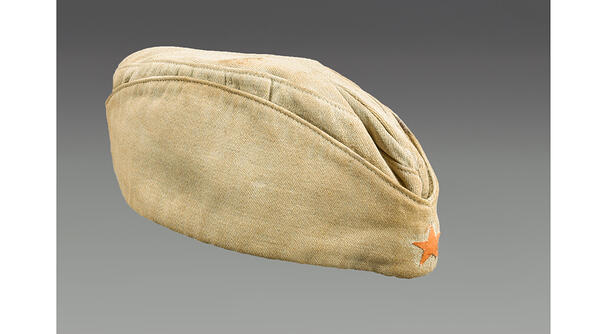Initially, the side cap, sewn from soft fabrics, was made exclusively for aviators. This headdress was compact and comfortable, so the pilot could carry it in his pocket or his bosom.
In the Red Army, side caps first appeared in January 1919. The dark green headdress was sewn with red piping and a Red Army star. In December 1935, two types of side caps were introduced.Khaki headdresses with edging, differing by the type of troops, and a cloth star, on which a Red Army star was attached in front, were intended for commanders. The enlisted personnel wore khaki caps without edging and stars.
In the armed forces of the USSR, such hats were intended for both men and women. Officers and praporshchiks (a junior officer rank in Imperial Russia), as well as michmans (midshipmen), wore caps with edging corresponding to the type of troops of colors.
The navy wore black half-wool officers’ caps with white edgings, as well as black cloth caps for sailors, and in tropical uniform they wore light blue cotton caps with a cloth visor and a strap. Officers' caps were made with cockades and sailors' caps with a star.
The cap from the exposition of the Kirov Museum belonged to Pavel Zorin, a native of the village of Zorin in the Kirov region. He was a Full Cavalier of the Order of Labour Glory and had orders of all three degrees. This set of awards was equated to the title of Hero of the Soviet Union.
Pavel Zorin was the commander of a mortar crew of a rifle regiment in the 2nd Baltic Front.Zorin received the Order of Glory of the 3rd degree for the battle that took place in January 1944 near the village of Podrechye, Pskov region.
In the Red Army, side caps first appeared in January 1919. The dark green headdress was sewn with red piping and a Red Army star. In December 1935, two types of side caps were introduced.Khaki headdresses with edging, differing by the type of troops, and a cloth star, on which a Red Army star was attached in front, were intended for commanders. The enlisted personnel wore khaki caps without edging and stars.
In the armed forces of the USSR, such hats were intended for both men and women. Officers and praporshchiks (a junior officer rank in Imperial Russia), as well as michmans (midshipmen), wore caps with edging corresponding to the type of troops of colors.
The navy wore black half-wool officers’ caps with white edgings, as well as black cloth caps for sailors, and in tropical uniform they wore light blue cotton caps with a cloth visor and a strap. Officers' caps were made with cockades and sailors' caps with a star.
The cap from the exposition of the Kirov Museum belonged to Pavel Zorin, a native of the village of Zorin in the Kirov region. He was a Full Cavalier of the Order of Labour Glory and had orders of all three degrees. This set of awards was equated to the title of Hero of the Soviet Union.
Pavel Zorin was the commander of a mortar crew of a rifle regiment in the 2nd Baltic Front.Zorin received the Order of Glory of the 3rd degree for the battle that took place in January 1944 near the village of Podrechye, Pskov region.
The crew hit two observation posts from a mortar under his command, an anti-tank gun, an enemy mortar, 2 machine guns, and about 20 enemy soldiers. Zorin received the Order of Glory of the Second degree for fighting in July 1944, when he transported a mortar with ammunition across the Western Bug River using improvised means. In the battle on the bridgehead, he remained the only one from his calculation but managed to destroy 2 machine-gun points and about 10 enemy soldiers, and then supported the crossing of the Vistula River with fire. Zorin was awarded the third Order of Glory of the First degree after the end of the Great Patriotic War, in November 1945.



